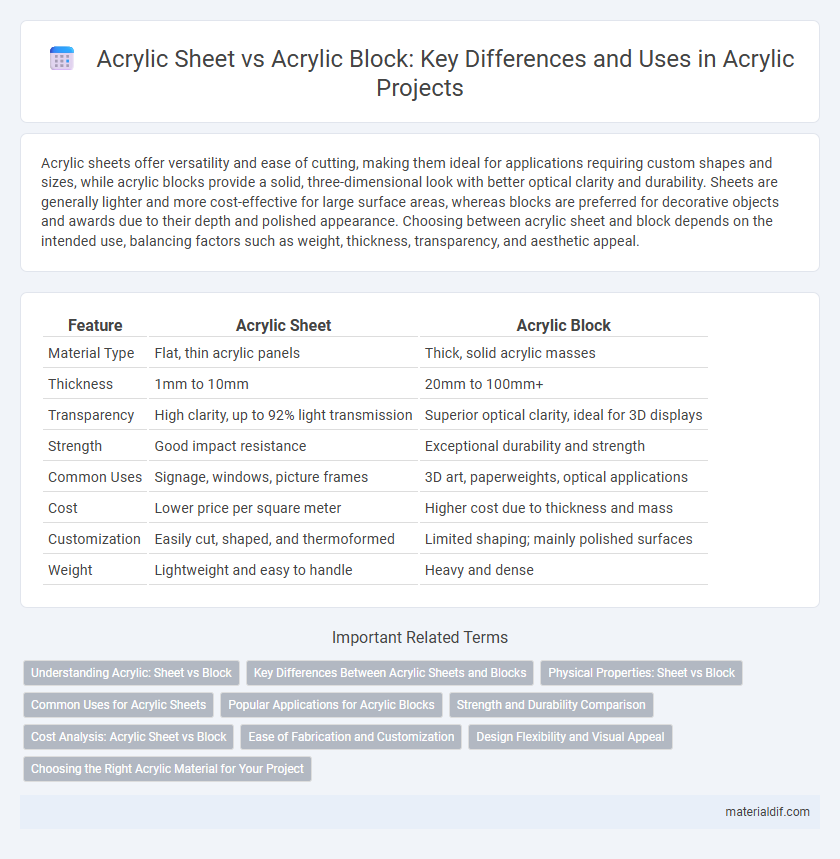Acrylic sheets offer versatility and ease of cutting, making them ideal for applications requiring custom shapes and sizes, while acrylic blocks provide a solid, three-dimensional look with better optical clarity and durability. Sheets are generally lighter and more cost-effective for large surface areas, whereas blocks are preferred for decorative objects and awards due to their depth and polished appearance. Choosing between acrylic sheet and block depends on the intended use, balancing factors such as weight, thickness, transparency, and aesthetic appeal.
Table of Comparison
| Feature | Acrylic Sheet | Acrylic Block |
|---|---|---|
| Material Type | Flat, thin acrylic panels | Thick, solid acrylic masses |
| Thickness | 1mm to 10mm | 20mm to 100mm+ |
| Transparency | High clarity, up to 92% light transmission | Superior optical clarity, ideal for 3D displays |
| Strength | Good impact resistance | Exceptional durability and strength |
| Common Uses | Signage, windows, picture frames | 3D art, paperweights, optical applications |
| Cost | Lower price per square meter | Higher cost due to thickness and mass |
| Customization | Easily cut, shaped, and thermoformed | Limited shaping; mainly polished surfaces |
| Weight | Lightweight and easy to handle | Heavy and dense |
Understanding Acrylic: Sheet vs Block
Acrylic sheets are thin, versatile panels ideal for glazing, signage, and protective barriers, offering excellent clarity and ease of cutting. Acrylic blocks are thicker, solid pieces that provide depth and a premium aesthetic for displays, awards, and decorative objects. Choosing between acrylic sheets and blocks depends on the application's requirements for thickness, strength, and visual impact.
Key Differences Between Acrylic Sheets and Blocks
Acrylic sheets are thin, flat panels commonly used for glazing, signage, and protective barriers due to their lightweight and flexible properties, while acrylic blocks are thick, solid masses ideal for optical clarity in displays and paperweights. Sheets offer easier fabrication options such as cutting, bending, and machining, whereas blocks provide superior depth effects and durability in 3D applications. The choice between acrylic sheets and blocks depends on the specific requirements for thickness, transparency, and structural strength.
Physical Properties: Sheet vs Block
Acrylic sheets typically offer greater flexibility and ease of fabrication due to their thinner profile, while acrylic blocks provide enhanced rigidity and dimensional stability because of their solid, thicker structure. Sheets generally have a lower weight-to-thickness ratio, making them ideal for lightweight applications, whereas blocks exhibit superior impact resistance and optical clarity, making them suitable for premium display cases or optical components. Thermal expansion rates are similar in both forms, but acrylic blocks are less prone to warping under stress compared to thinner sheets.
Common Uses for Acrylic Sheets
Acrylic sheets are widely used for signage, display cases, and protective barriers due to their lightweight, high clarity, and ease of fabrication. These sheets provide excellent impact resistance and UV stability, making them ideal for outdoor advertisements and glazing applications. Compared to acrylic blocks, sheets are more versatile for cutting, shaping, and mounting in various commercial and architectural projects.
Popular Applications for Acrylic Blocks
Acrylic blocks are widely used in decorative displays, photo frames, and awards due to their clarity and durability. Their solid, three-dimensional structure makes them ideal for embedding objects, creating depth, and enhancing visual appeal in retail and interior design. Unlike acrylic sheets, blocks provide a sturdy, sculptural presence often favored for promotional and artistic applications.
Strength and Durability Comparison
Acrylic sheets offer excellent strength with impact resistance approximately 10-24 times higher than glass, making them suitable for protective barriers and windows. Acrylic blocks, being thicker and solid, provide superior durability and rigidity, ideal for heavy-duty applications requiring enhanced structural support and resistance to cracking or breaking. Both forms resist UV radiation and weathering, but blocks maintain integrity better under prolonged physical stress or harsh environmental conditions.
Cost Analysis: Acrylic Sheet vs Block
Acrylic sheets generally offer a more cost-effective solution for large surface applications due to lower manufacturing expenses and ease of cutting, making them ideal for budget-conscious projects. Acrylic blocks, while more expensive per unit, provide superior optical clarity and depth, justifying the higher cost in premium displays and signage. Comparing costs, acrylic sheets cost approximately $10 to $30 per square foot, whereas acrylic blocks range from $40 to $100 per piece depending on thickness and quality.
Ease of Fabrication and Customization
Acrylic sheets offer greater ease of fabrication due to their thin, flat form, allowing for precise cutting, drilling, and shaping with standard tools, making them ideal for customized projects requiring intricate designs. Acrylic blocks, being thicker and more rigid, present challenges in modification but provide superior durability and visual depth, often preferred for solid displays or decorative applications. Customization of acrylic sheets is highly versatile, supporting bending and engraving, whereas blocks are typically customized through surface treatments and polishing.
Design Flexibility and Visual Appeal
Acrylic sheets offer greater design flexibility due to their thin profile and ease of cutting, shaping, and layering for custom applications. Acrylic blocks, with their substantial thickness and solid structure, enhance visual appeal by providing depth, clarity, and a unique 3D effect, making them ideal for premium displays and art pieces. Choosing between acrylic sheets and blocks depends on whether the priority is customizable design or striking visual impact.
Choosing the Right Acrylic Material for Your Project
Acrylic sheets offer versatile options for projects requiring flat, rigid surfaces with ease of cutting and shaping, making them ideal for signage, glazing, and displays. Acrylic blocks provide a solid, three-dimensional structure with high optical clarity and durability, perfect for awards, awards, and decorative pieces. Selecting the right acrylic material depends on project requirements such as thickness, transparency, and structural integrity, ensuring optimal performance and visual appeal.
Acrylic Sheet vs Acrylic Block Infographic

 materialdif.com
materialdif.com